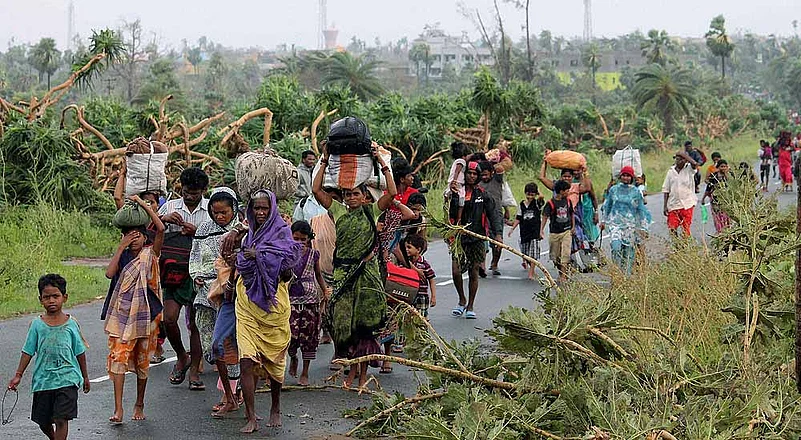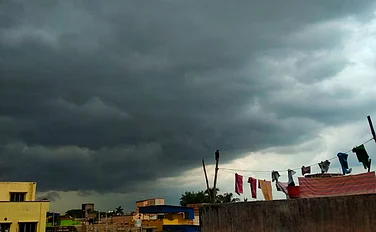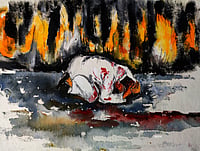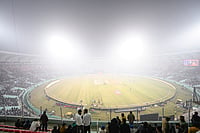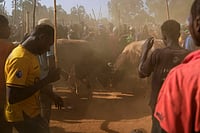For a nation whose bloody history is pockmarked with epic disasters—floods, famines, droughts, earthquakes, cyclones, the tsunami—and even more spectacular failures of rescue and rehabilitation, October 12 threatened to top them all. But for all her ferocity and notoriety, Cyclone Phailin meekly kissed the earth and vanished, and the republic of bad news suddenly found itself in the unusual position of having to deal with the good. Many—36 at last count—perished, but it was less than what had loomed. Durga Puja 2013 had a better than expected ending on the east coast.
The prime reason, of course, was plain good luck. Phailin had lost much of her steam en route from Thailand. A promised speed of 350 km per hour had reduced to 200 kmph as she swirled over the Bay of Bengal for over a week. Katrina II she wasn’t. But a surprising reason for the happy augury was that the State—and the states—was less ready to be surprised. In other words, India was better prepared. “The whole world was watching. We managed to save so many lives because all of us worked together,” says Prashant Dar, commandant, National Disaster Response Force (NDRF).
From watching the skies to working the phones, and showing great presence of mind, these are among the heroes in Orissa and Andhra Pradesh who staved off a flood of blood.
Weathermen: Phailin moved into the bay only on October 7, but Sarat Sahu, director of the Indian meteorological department in Bhubaneswar, had begun working the phones on October 3. “I was doing a routine check (on the Numerical Weather Prediction Model, used to track weather conditions at Met offices) when my attention was drawn to the massive tropical depression that had formed southeast of the Bay of Bengal, beyond the Malay Peninsula. I immediately knew the course it could take.”
So, long before the system posed any actual threat to India, Sahu and his IMD colleagues across India were constantly discussing, monitoring and keeping the relevant government departments informed about the path and progress of the cyclone. “It was a united effort. What helped was that we were not taken by surprise. We were prepared. In the end, the secret to the success is perhaps the timely action taken,” says Sahu. While Phailin did originate off Thailand, the phenomenon wasn’t new to Indian officials, who had dealt with Laila and Neelam and Jal in the last three years. “Various models were run through supercomputers at the IMD office in Delhi,” says Hyderabad Met director Sudhakar Rao. “Constant research helped us zero in so accurately on landfall, almost down to a range of 30 km,” he says.

Cyclone struck Phailin waves lash a fishing harbour in Vizag. (Photograph by Reuters, From Outlook 28 October 2013)
Bureaucrats: “I want every single person evacuated from the demarcated danger zones. Not even a stray dog should be found roaming there.” With these words to the collectors of his state’s 12 coastal districts on October 9, P.K. Mahapatra, Orissa’s special relief commissioner, flagged off the four-day preparation. By the time Phailin achieved landfall at Gopalpur in Ganjam district, a record 983,553 people had been evacuated. “It was perhaps the largest number of people ever to have been evacuated in Indian history and that too within a span of 36 to 40 hours,” Mahapatra points out.
The pre-disaster management entailed not only mass evacuation but setting up of relief camps (besides 247 relief camps in cyclone zones, nearly 10,000 college, school and other buildings), organising medical facilities, food, drinking water, sanitation, etc. Getting vehicles off the roads, issuing warnings along the coast too played a big part in minimising casualty. “Though it was Durga Puja season, the leave of every single employee was cancelled. No one complained. Everyone was ready to do their bit,” says Mahapatra.
The collector of Puri district during the 1999 supercyclone, which officially killed 12,640, Mahapatra says it was the experience of that tragedy and the determination that it should never be repeated which made the state authorities swing into action. “The police was instructed to use force if necessary to drag people out of their houses and move them to safety because often we face resistance from people who don’t understand the magnitude of the danger involved. Our mission was zero casualties,” he says.
“In some places, people were refusing to budge from their houses and were aggressively pushing us away. Wahan danda chalana pada (We had to use force),” says NDRF’s Dar.
State Governments: For Naveen Patnaik in election mode and Kiran Kumar Reddy battling a bifurcation of his state, Phailin threw up different challenges. But in their own understated ways, both did their bit to provide leadership at an hour of need. Reddy met officials on an almost hourly basis.
T. Radha, Andhra Pradesh commissioner for disaster management, who supervised the evacuation of pilgrims from the state in the Uttarakhand cloudburst, underlines the role played by the state in minimising loss of life with the shift to pucca housing in rural areas by successive governments. As per preliminary reports, only 400 houses were damaged in the three districts of Srikakulam, Vizianagaram and Visakhapatnam. Over the years, the state has built over 1,000 cyclone shelters along the 1,048-km-long coastline.
On average, Andhra’s three affected districts receive a rainfall of 3 mm a day in rabi season. On the day of Phailin, they received 200 mm. A little foresight led Srikakulam collector Saurabh Gaur to instruct irrigation officials to empty 1.5 cusecs from the Madduvalasa reservoir. Similarly all the shutters of the Vamsadhara river were opened and water was let out into the sea. This prevented post-cyclone flooding. In all, 1,34,426 people were evacuated from 294 villages in the three districts. BSNL exchanges were given seven days’ supply of diesel. This protected communication lines to a large extent.
Collector Gaur, who made night halts in various villages prior to the arrival of Phailin, says the word was spread even to people running tea bunks, small pan shops, destitutes and migrant labourers in coconut gardens. In short, not a single person’s life was taken for granted. Initially, there was resistance to evacuation because fishermen considered themselves “water-educated and Gangaputras”. It was then that the sarpanches and tahsildars contacted community elders or peddakapus and convinced about the imminent danger.
Television Media: P.K. Mahapatra acknowledges that the media—especially electronic media and All India Radio—played a major role in disseminating information on the looming threat due to high wind and inundation. “Knowledge reduces panic,” says Radha. Senior Orissa journalists point out that theirs was a much bigger role than just informing the public. Says Sampad Mahapatra, former NDTV bureau chief, “It was the media hype—or overkill as it turned out to be—on the possible enormity of Phailin’s destructive powers as well as media’s constant references to how an earlier government had fallen after its abject failure to tackle the 1999 supercyclone that made it a do-or-die battle for an election-ready government. It was also media reports on the ‘killer cyclone’ that scared the people and they needed little persuasion to scurry for safer places. This is what actually helped the evacuation process.”
By Dola Mitra in Calcutta and Madhavi Tata in Hyderabad






